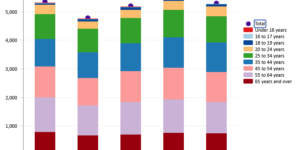While the January reinsurance renewals proved to be the toughest and most grueling for decades, the April 1 renewals, driven by the Japanese P/C market, were a much calmer affair, according to Swiss Re.
“Overall, client and reinsurer expectations were better aligned than at Jan. 1, 2023,” said Gianfranco Lot, chief underwriting officer P&C Reinsurance at Swiss Re, in a market commentary issued by the reinsurer.
“While 1.1 was quite uncertain, 1.4 was much more methodical. Market and economic conditions and dynamics didn’t change dramatically from 1.1, so the process was much more measured,” he said.
“Expectations were better managed for 1.4 than the 1.1 renewals since the 1.1 renewal enabled clients to anticipate rate increases, so they were therefore able to prepare and adjust their budgets accordingly, and the use of retrocessions enabled reinsurers to calculate capital supply more accurately while remaining conscious of required returns,” he said.
Pricing, Retentions, Terms & Conditions
The pricing momentum seen in the Jan. 1 renewals continued, “as did higher retentions and tighter terms and conditions, with changes in relation to structures and wordings,” Lot added. “This was particularly evident around areas such as infectious diseases, non-damage business interruption and loss occurrence definitions.”
He explained that Japan is by far the biggest market renewing at April 1, with a smaller number of treaties renewing in India as well as for several of Swiss Re’s international clients.
The April renewals are also a significant renewal date for specialty business, he said, offering two observations about marine and aviation. “In marine, we still see a need to further clarify war coverages following the outbreak of the Ukraine war in 2022. In aviation business, discussions around sideways limitations on proportional treaties have progressed and we see more and more markets subscribing to that approach.”
Lot went on to address the client response to the April 4 renewals.
“Understandably, there was a need for discussion with clients and brokers, especially in Japan, where reinsurance rates had already been adjusted in the last years. However, the global increase in the risk frequency and severity trend of natural catastrophe events had to be considered,” he said.
“The South African flood loss that hit KwaZulu-Natal in April 2022 was a [case in point]. Here, the floods caused widespread devastation. Further, where medical reimbursement covers from COVID-19 had been underestimated by the reinsurance market, a further costing and pricing review was triggered. These formed key discussions alongside natural catastrophe risk exposures, which is always a big area of discussion.”
Lot said that good progress was achieved in relation to data transparency, which is an issue across the entire global re/insurance value chain. “Many clients were able to provide more granular data points than before that enabled our own underwriters to better understand the risks and price them accordingly.”
Based on the experiences at Jan. 1 and April 1, Lot discussed the outlook for July 1 and the reinsurance conference season.
“With 1.7 focused on the U.S. and Australia, there’s likely to be more demand. In this sense, I expect a continuation of the current market momentum,” Lot said.
“Walking into the conference season, I am anticipating discussions around the increasing frequency of natural catastrophe events and secondary perils. So far this year, we’ve witnessed the earthquakes in Turkey and Syria, tropical cyclone Gabriel, several tornadoes, and floods in New Zealand, too. So that seems to be elevated, at least from a first-quarter perspective. It’s hard to say how that will change, but by the half-year point we will have more data points.”
Lot also expects potential issues in the casualty market. “Some of the court verdicts we are seeing are still significant. The Swiss Re Institute reported that the median size of large awards rose by 26 percent for general liability cases and by 32 percent for vehicle negligence cases over the past 10+ years. This will inform renewal conversations on casualty business,” he continued.
He expects upcoming renewal conversations to be about the continuing momentum for pricing hikes, terms and conditions, and reinsurance structures, along with topics such as cyber, economic inflation and weather-related events.





















 What’s Not Changing in 2025: Homeowners Outlook, Re Retentions
What’s Not Changing in 2025: Homeowners Outlook, Re Retentions  California Vocational School CEO Charged With 23 Counts of Insurance Fraud
California Vocational School CEO Charged With 23 Counts of Insurance Fraud  Viewpoint: Strategies for Brokers as M&A Slows and Insurance Rates Soften
Viewpoint: Strategies for Brokers as M&A Slows and Insurance Rates Soften  2025 Underwriting Profit and ‘Shop-a-Palooza’ Predicted for Auto Insurance
2025 Underwriting Profit and ‘Shop-a-Palooza’ Predicted for Auto Insurance 